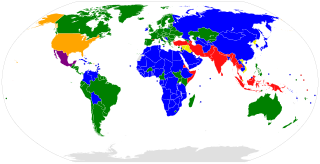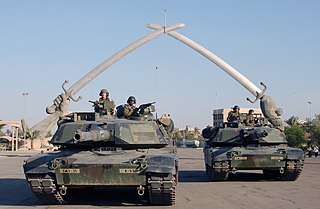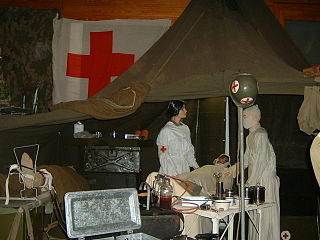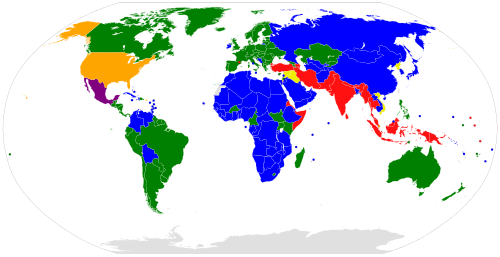
The Geneva Convention relative to the Protection of Civilian Persons in Time of War, more commonly referred to as the Fourth Geneva Convention and abbreviated as GCIV, is one of the four treaties of the Geneva Conventions. It was adopted in August 1949, and came into force in October 1950. While the first three conventions dealt with combatants, the Fourth Geneva Convention was the first to deal with humanitarian protections for civilians in a war zone. There are currently 196 countries party to the 1949 Geneva Conventions, including this and the other three treaties.

An unlawful combatant, illegal combatant or unprivileged combatant/belligerent is a person who directly engages in armed conflict in violation of the laws of war and therefore is claimed not to be protected by the Geneva Conventions. The International Committee of the Red Cross points out that the terms "unlawful combatant", "illegal combatant" or "unprivileged combatant/belligerent" are not defined in any international agreements. While the concept of an unlawful combatant is included in the Third Geneva Convention, the phrase itself does not appear in the document. Article 4 of the Third Geneva Convention does describe categories under which a person may be entitled to prisoner of war status. There are other international treaties that deny lawful combatant status for mercenaries and children.

The law of war is the component of international law that regulates the conditions for initiating war and the conduct of hostilities. Laws of war define sovereignty and nationhood, states and territories, occupation, and other critical terms of law.

Combatant is the legal status of a person entitled to directly participate in hostilities during an armed conflict, and may be intentionally targeted by an adverse party for their participation in the armed conflict. Combatants are not afforded immunity from being directly targeted in situations of armed conflict and can be attacked regardless of the specific circumstances simply due to their status, so as to deprive their side of their support.

Non-combatant is a term of art in the law of war and international humanitarian law to refer to civilians who are not taking a direct part in hostilities; persons, such as combat medics and military chaplains, who are members of the belligerent armed forces but are protected because of their specific duties ; combatants who are placed hors de combat; and neutral persons, such as peacekeepers, who are not involved in fighting for one of the belligerents involved in a war. This particular status was first recognized under the Geneva Conventions with the First Geneva Convention of 1864.

Military occupation, also known as belligerent occupation or simply occupation, is the temporary military control by a ruling power over a territory that is outside of that power's sovereign territory. The territory is then known as the occupied territory and the ruling power the occupant. Occupation is distinguished from annexation and colonialism by its intended temporary duration. While an occupant may set up a formal military government in the occupied territory to facilitate its administration, it is not a necessary precondition for occupation.
International humanitarian law (IHL), also referred to as the laws of armed conflict, is the law that regulates the conduct of war. It is a branch of international law that seeks to limit the effects of armed conflict by protecting persons who are not participating in hostilities and by restricting and regulating the means and methods of warfare available to combatants.
Stress and duress is a term which has been used by the United States to describe interrogation techniques authorized for use by the United States Armed Forces upon detainees who are determined to be a threat to the United States during the War on Terrorism. These techniques are claimed to cause "inhuman and degrading treatment" but which the George W. Bush administration claims do not cause "suffering of the particular intensity and cruelty implied by the word torture".

Protocol I is a 1977 amendment protocol to the Geneva Conventions concerning the protection of civilian victims of international war, such as "armed conflicts in which peoples are fighting against colonial domination, alien occupation or racist regimes". In practice, Additional Protocol I updated and reaffirmed the international laws of war stipulated in the Geneva Conventions of 1949 to accommodate developments of warfare since the Second World War (1937–1945).
Enemy combatant is a term for a person who, either lawfully or unlawfully, engages in hostilities for the other side in an armed conflict, used by the U.S. government and media during the War on terror. Usually enemy combatants are members of the armed forces of the state with which another state is at war. In the case of a civil war or an insurrection "state" may be replaced by the more general term "party to the conflict".

Protocol II is a 1977 amendment protocol to the Geneva Conventions relating to the protection of victims of non-international armed conflicts. It defines certain international laws that strive to provide better protection for victims of internal armed conflicts that take place within the borders of a single country. The scope of these laws is more limited than those of the rest of the Geneva Conventions out of respect for sovereign rights and duties of national governments.

The Geneva Convention on Prisoners of War was signed at Geneva, July 27, 1929. Its official name is the Convention relative to the Treatment of Prisoners of War, Geneva July 27, 1929. It entered into force 19 June 1931. It is this version of the Geneva Conventions which covered the treatment of prisoners of war during World War II. It is the predecessor of the Third Geneva Convention signed in 1949.

Detention is the process whereby a state or private citizen lawfully holds a person by removing their freedom or liberty at that time. This can be due to (pending) criminal charges preferred against the individual pursuant to a prosecution or to protect a person or property. Being detained does not always result in being taken to a particular area, either for interrogation or as punishment for a crime. An individual may be detained due a psychiatric disorder, potentially to treat this disorder involuntarily. They may also be detained for to prevent the spread of infectious diseases such as tuberculosis.

The Military Commissions Act of 2006, also known as HR-6166, was an Act of Congress signed by President George W. Bush on October 17, 2006. The Act's stated purpose was "to authorize trial by military commission for violations of the law of war, and for other purposes".
The United Nations Mercenary Convention, officially the International Convention against the Recruitment, Use, Financing and Training of Mercenaries, is a 2001 United Nations treaty that prohibits the recruitment, training, use, and financing of mercenaries. At the 72nd plenary meeting on 4 December 1989, the United Nations General Assembly concluded the convention as its resolution 44/34. The convention entered into force on 20 October 2001 and has been ratified by 46 states.

The Geneva Conventions are international humanitarian laws consisting of four treaties and three additional protocols that establish international legal standards for humanitarian treatment in war. The singular term Geneva Convention colloquially denotes the agreements of 1949, negotiated in the aftermath of the Second World War (1939–1945), which updated the terms of the two 1929 treaties and added two new conventions. The Geneva Conventions extensively define the basic rights of wartime prisoners, civilians and military personnel; establish protections for the wounded and sick; and provide protections for the civilians in and around a war-zone.
The Geneva Convention for the Amelioration of the Condition of the Wounded and Sick in Armies in the Field, consisting of 39 articles in French, was adopted on 27 July 1929, at the end of the Diplomatic Conference of Geneva of 1929, which met from the 27 July until the 1 August of that year.
Prisoners' rights in international law are found in a number of international treaties. For the most part these treaties came into existence following the two World Wars and the body of law continues to be added to and amended.

Protected persons is a legal term under international humanitarian law and refers to persons who are under specific protection of the 1949 Geneva Conventions, their 1977 Additional Protocols, and customary international humanitarian law during an armed conflict.
The prohibition of torture is a peremptory norm in public international law—meaning that it is forbidden under all circumstances—as well as being forbidden by international treaties such as the United Nations Convention Against Torture.













